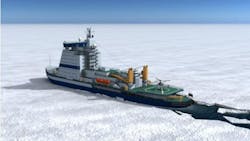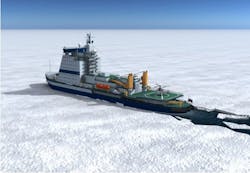Russia Constructing World’s Largest Nuclear-Powered Icebreaker
The Russian Federation has begun construction of the world’s largest universal nuclear-powered icebreaker. Officially called the LK-60 (unofficially, the Arctic), the ship will generate 175 MW of electric power. The cost for the record-breaking vessel is reported to be 36,959 billion rubles ($1.16 billion).
Capable of navigating in both the Arctic Ocean and the shallow waters of Siberian rivers, the 173-m (568 ft) Arctic is being built by the Baltiysky Zavod (Baltic shipyard), St Petersburg, and scheduled for completion by 2017.
Powered by two RITM-200 pressurized water reactors, the Arctic will be able to crack ice fields 2.9-m (9½-ft) thick. It will be rated Ice Class 9, the highest, meaning the ship will be able to break ice in the Arctic area all year round.
Contracts for the vessel’s hydraulic steering gear and winches were awarded to Fluidmecanica SAU, of Vigo, Spain. In addition to providing the hydraulic steering gear, Fluidmecanica will supply the ship's traction winch, with a dynamic pull capacity of 800 kN and brake-holding load of 5,100 kN; a storage winch, with a capacity of 1,000-m of 58-mm cable; and a 480-ton damping device.


